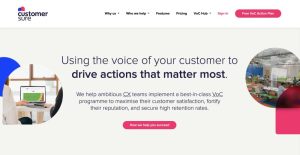Imagine running a restaurant where the chef prepares exquisite burgers, but forget that the diners in the neighborhood only want pasta. The customers would leave feeling frustrated, and unlikely to return. That is your business when you lack a view on customer feedback: a fine dining establishment with no buyer.
A customer experience platform can solve the problems by capturing every “Yum” and “Meh” from your clientele. More than that, these platforms turn feedback into insights, actions, and help create a fine buying experience.
Keep reading on how to leverage eCommerce customer feedback with a customer experience platform, making sure every customer leaves satisfied and eager to return.
Why is Customer Feedback Important to eCommerce Businesses?

Customers’ feedback can be widely regarded as the central ingredient to the creation and growth of eCommerce businesses. It is not just some people’s subjective estimations, but rather the compass that orients businesses’ strategic directions and changes.
According to Podium, 93% of consumers say that reviews impact what they buy while The Spiegel Research Center found that a five-review product is 270% more likely to be purchased than a no-review product. A Hiver research showed that 89% of customers publicly talk about their bad customer support experience, which turns existing customers away. Those numbers alone prove some benefits of customer feedback for an eCommerce store.
So what is customer feedback? It is the information that customers give a business about their experience. It includes opinions, reactions, insights, preferences, and complaints about a product or service.
Common types of customer feedback include:
- Reviews
- Customer service feedback
- Surveys
- Sales or customer success feedback
- Social media posts
- Comments
- Support tickets
- Returns
What Is an eCommerce Customer Experience Platform?
As you may notice, customer feedback can come from many channels and in many forms. This is where a customer experience (CX) platform comes in handy.
The customer experience platform is the tool that enables the business to manage customer journeys effectively. Thanks to this, brands can work out a plan regarding the delivery of customer experiences through various touch points, both digital and physical.
The platform manages interactions across all touchpoints: synchronizing, organizing, and automation. This is to make sure that you can meet all your customer’s requirements and respond to problems and opportunities as they arise.
Some types of customer experience platforms are:
- Customer Feedback and Survey Platforms
- Customer Relationship Management (CRM) Systems
- Customer Data Platforms (CDP)
- Social Media Management Platforms
- Customer Success Platforms
- Customer Journey Analytics Platforms
We will get to some notable names of customer experience platforms for eCommerce in seconds, but before that, let’s see..
How to Leverage eCommerce Customer Feedback With a Customer Experience Platform

1. Collect data on customer feedback from all channels
First, you need to gather eCommerce customer feedback to determine valuable insights to develop the store. The key strategies for collecting customer feedback are:
Collect data on many channels and devices: Use various channels like reviews, surveys, social media, website messages, marketplaces, and direct communication to gather feedback. A POS system is also an excellent source for providing data on purchasing behaviors.
Implement new tech: Tools like chatbots and surveys are essential to automate the feedback collection process. You can also combine a finance management tool like Quickbooks and POS to see the direct impact of customers’ buying behavior on the financial performance, which will show how they react to your products and campaigns over time.
Invite for participation: Encourage buyers to share their opinions through incentives, discounts, or special member access. This tactic has been used by multiple global brands such as Adidas or Uniqlo.
2. Analyze and understand each stage of the customer journey
Once the customer data has been collected, it is time to deal with the analysis of collected information. That way you can address your difficulties or have the best strategies.
Group feedback into categories such as user experience, product quality, customer service, etc. Categorization of feedback aids in coming up with a list of concerns that need to be addressed. Next, point out and rate the most significant problems reported by customers. This step guarantees that efforts and resources are focused on tackling issues that are likely to provide the highest returns.
3. Identify customer experience and industry trends in real-time
The world of customer experience is usually dynamic. Organizations always seek to introduce new ways to meet and serve their customers. New solutions involve higher expectations but by leveraging feedback, you can keep fighting for the position in the given market.
Use a customer experience platform to track customer needs over time, such as which items are hot in the summer, or which items are declining in purchases. For trends, use tools like Google Trends or TikTok to see what’s hot with your target audience.
4. Refine the targeting and messaging strategy
A customer experience platform helps track satisfaction rates throughout the customer journey, you can understand what customers think about your brand and products — from the first time they visit your Instagram to when they place a purchase.
These results help learn what makes people excited about your brand and what makes them tell all their friends about it. You can use this information to refine the messages for each customer, create more happy buyers, and increase the conversion rate.
5. Create an action plan based on feedback data
More than the messages, you should create a structured plan for specific changes based on the analyzed feedback. Then, organize dedicated teams for increased efficiency. Consider making cross-functional teams between marketing, product development and customer services.
By taking actions based on eCommerce customer feedback, you are valuing their opinions and striving to create a better shopping experience. Meanwhile, your employees understand an important trait of the business: customer opinions matter.
6. Monitor the effectiveness of actions
To understand the effectiveness of the action plan, you need to monitor the impact. Here’s how you measure:
KPIs: Key performance indicators (KPIs) on feedback for an eCommerce store include the conversion rate, customer satisfaction scores, or support ticket volumes.
Analytics Tools: Tools like Merren and Google Analytics help track sales data, buyer behavior, and other relevant data to paint a clear picture of your customers.
Ongoing Feedback: Changes may have been made but that doesn’t mean the feedback gathering stops. Keep trying to find new insights and ensure your eCommerce business remains aligned with customer expectations.
7. Track brand reputation with customer feelings
The numbers are only a part of the story. That is why I mentioned customer feedback qualitative data. KPIs and NPS metrics can tell you a lot, but as a brand, you need to really step into the customer’s shoes.
So open-ended feedback (like direct conversations) lets you understand exactly what people are feeling about your brand and products. Just like a real person, if your brand is coming across as insincere, cold, pushy, etc. people won’t like buying from you even if the sales campaigns are still effective.
Customer feedback can be a much-needed reality check for any eCommerce business. Do they buy because they like your brand? Do they see your products as beloved items? That emotional connection is the highest goal.
Top eCommerce Customer Feedback Platforms
Merren – best to collect feedback through surveys

Merren is the fastest way to collect customer feedback through multichannel surveys. The platform supports WhatsApp, Facebook messenger, Instagram Messenger, dynamic emails & Chatbots so you can connect with buyers to receive their opinions.
Merren has also incorporated AI to help users build surveys in seconds for faster data collection. Their surveys also support more than 100+ languages, ensuring easy global reach out no matter where your customers are. Sign up for a 14 day free trial with Merren, no credit card required.
Customersure – best to analyze VOC (Voice Of Customers)

CustomerSure is a VoC platform made by customer experience experts to gather eCommerce customer feedback in a way that tells a story about consumer needs. It provides tools like heatmaps, league tables, and trend notifiers to understand each of the buyers.
CustomerSure is designed for large mid-market businesses and offers everything a serious company needs to improve customers’ lives, but with no ‘enterprise’ features that are too expensive to be out of reach.
Sender – best to use email marketing for feedback

Sender is an advanced, easy to use email marketing tool that organizes your communication campaigns so you can reach your clients in the best manner possible. You can perform both email and text message marketing and save a lot of time through automation. A standout feature is the advanced segmentation- it groups your audience based on behaviors and preferences, so your communication can be tailored to meet their specific needs.
Conclusion
Depending on your eCommerce business needs: managing high-volume communications, collecting customer insights, or analyzing the buying journeys, there are many CX platforms that will provide ways to leverage eCommerce customer feedback. Additionally, in many cases, you can even integrate these platforms.
But the essence here is true listening to the customer’s voice on their opinions on your brand, products, and experience. If you can understand that, then the insights can be gathered anywhere you meet the customers.
